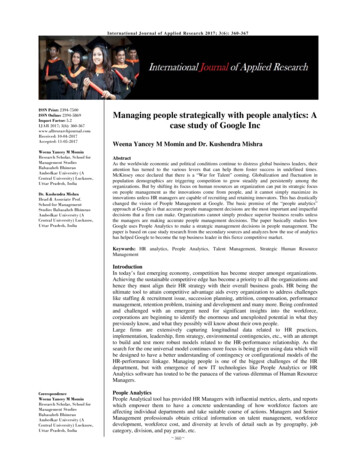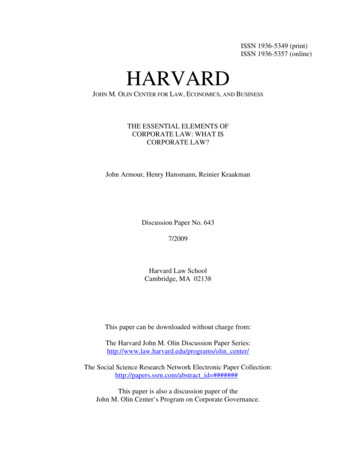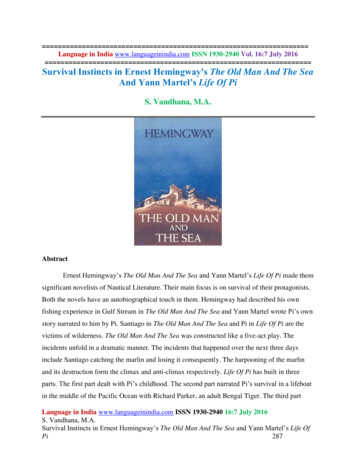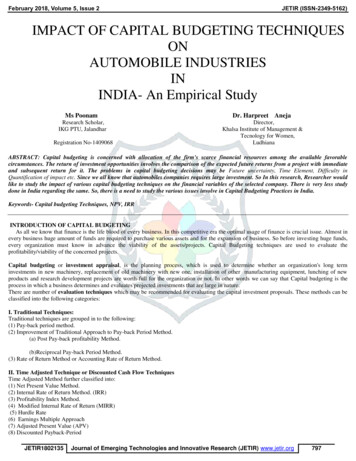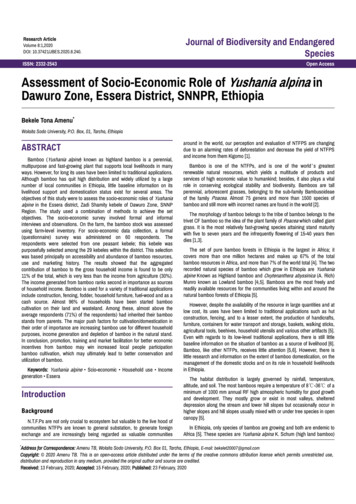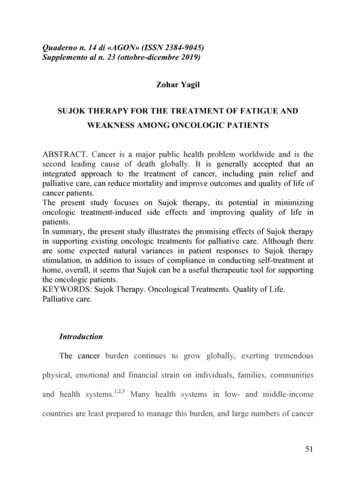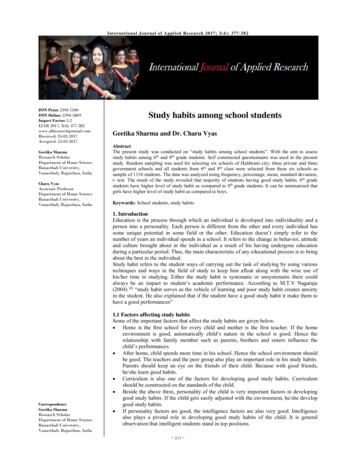
Transcription
Int ern a tio na l Jo u rna l of Appli ed R esea rch 201 7; 3(4): 377 -3 8 2ISSN Print: 2394-7500ISSN Online: 2394-5869Impact Factor: 5.2IJAR 2017; 3(4): 377-382www.allresearchjournal.comReceived: 24-02-2017Accepted: 25-03-2017Geetika SharmaResearch ScholarDepartment of Home ScienceBanasthali University,Vanasthali, Rajasthan, IndiaCharu VyasAssociate ProfessorDepartment of Home ScienceBanasthali University,Vanasthali, Rajasthan, IndiaStudy habits among school studentsGeetika Sharma and Dr. Charu VyasAbstractThe present study was conducted on “study habits among school students”. With the aim to assessstudy habits among 6th and 8th grade students. Self constructed questionnaire was used in the presentstudy. Random sampling was used for selecting six schools of Haldwani city; three private and threegovernment schools and all students from 6th and 8th class were selected from these six schools assample of 1116 students. The data was analyzed using frequency, percentage, mean, standard deviation,t- test. The result of the study revealed that majority of students having good study habits. 6th gradestudents have higher level of study habit as compared to 8th grade students. It can be summarized thatgirls have higher level of study habit as compared to boys.Keywords: School students, study habits1. IntroductionEducation is the process through which an individual is developed into individuality and aperson into a personality. Each person is different from the other and every individual hassome unique potential in some field or the other. Education doesn’t simply refer to thenumber of years an individual spends in a school. It refers to the change in behavior, attitudeand culture brought about in the individual as a result of his having undergone educationduring a particular period. Thus, the main characteristic of any educational process is to bringabout the best in the individual.Study habit refers to the student ways of carrying out the task of studying by using varioustechniques and ways in the field of study to keep him afloat along with the wise use ofhis/her time in studying. Either the study habit is systematic or unsystematic there couldalways be an impact to student’s academic performance. According to M.T.V Nagaraju(2004) [4] “study habit serves as the vehicle of learning and poor study habit creates anxietyin the student. He also explained that if the student have a good study habit it make them tohave a good performances”CorrespondenceGeetika SharmaResearch ScholarDepartment of Home ScienceBanasthali University,Vanasthali, Rajasthan, India1.1 Factors affecting study habitsSome of the important factors that affect the study habits are given below. Home is the first school for every child and mother is the first teacher. If the homeenvironment is good, automatically child’s nature in the school is good. Hence therelationship with family member such as parents, brothers and sisters influence thechild’s performances. After home, child spends more time in his school. Hence the school environment shouldbe good. The teachers and the peer group also play an important role in his study habits.Parents should keep an eye on the friends of their child. Because with good friends,he/she learn good habits. Curriculum is also one of the factors for developing good study habits. Curriculumshould be constructed on the standards of the child. Beside the above three, personality of the child is very important factors in developinggood study habits. If the child gets easily adjusted with the environment, he/she developgood study habits. If personality factors are good, the intelligence factors are also very good. Intelligencealso plays a pivotal role in developing good study habits of the child. It is generalobservation that intelligent students stand in top positions. 377
International Journal of Applied Research Community is also an important factor for developinggood study habits. Community has to arrange thecommunity centers such as library facilities, communityresource centers, information centers, etc. a goodcommunity provide necessary facilities for good studyhabits.Study habits may be a good or poor once-1.2 Good study habitsGood study habits can be defined as to have a clean,organized area for the studying, keeping good notes, readingtextbooks as well as studying at the same time each day.Learning to listen anything discussed and rememberingdetail are important beginning of developing good studyhabit. Children develop good study habit in school bycompleting small task and by building an enthusiasm forlearning. It grows each passing year of school, whenchildren have positive attitudes and when schoolwork ischallenging. “Good study habits include many differentskills: time management, self-discipline, concentration,memorization, organization and efforts”.1.3 Poor study habitsPoor study habit included bunking class, not doing theirwork at time, excessive watching TV or playing videogames instead of studying, easily distracted, usually readwithout recognizing meaning, careless, messy in theirpaperwork. In general term, studying is the application ofmental faculties to acquire knowledge. Material is carefullyconsidered, examined, or analyzed. Typically, details arereviewed attentively, and material is read with the intentionof learning and remembering. When this process is usuallyaccomplished ineffectively or inefficiently then it is called achild has poor study habits.1.4 Causes of poor study habits Not know how to study: - Most of the students do notaware how to study. They may never have learned theskill involved. Their poor study habits are a result ofusing whatever approaches they have naturallydeveloped or picked up from a variety of sources.Student may not know how to use the library ordictionary or read a map, graph or table. Learning problem: - any form of mental retardation isan obvious cause of study problem. Less obvious, butrelatively frequent, is some form of learning disability.Many forms of serious reading problem (dyslexia) maygo unrecognized. Any weakness in the process ofreading is a direct cause of study problem wherereading is required. Psychological problem: - many psychologicalproblems can lead to difficulties in studying. Tensioncaused by family or peer interaction can lead todifficulty in concentrating. Anxiety, sadness andworries are also detrimental. Daydreaming or fatiguessimilarly interfere with efficiency. Fear of failure,dependency, feeling of inadequacy, and pessimism canlead to not wanting to try to study or to ineffectivestudying. Other problem: such as Lacks of peacefulenvironment, availability of space, knowledge ofparents, finance, one of the parents are not live are themajor causes of poor study habits.1.5 Statement of the problem“Study habits among 6th and 8th grade students”.1.6 ObjectivesTo assess the study habits of students among 6th and 8thgrade.1.7 DelimitationThe study was delimited to 6th and 8th grade students ofHaldwani city.2. MethodologyThe chapter contains relevant information pertaining toresearch design. It includes the methodological aspect suchas selection of tool, techniques of statistical analysis in orderto achieve the objectives. Locale: The study was conducted in Haldwani city ofUttarakhand. Size and selection of sample: The total sample sizeundertaken for the study was 1116 students. Theresearcher has covered all students from the selected 3government (322) and 3 private (794) schools. Schoolswere selected from random sampling. Tool used in the study: self-constructed questionnairewas used for data collection. Description of the tool: The questionnaire wasdeveloped by the researcher to analysis study habits ofstudents among VI and VIII grade. The tool has beendivided into six dimensions that were timemanagement, concentration, study techniques, parentalinvolvement, teacher involvement and examinationrelated study habits. Scoring: The questionnaire was divided under twobroad sections. The part I comprised of 40 close endedstatements and part II comprised of 6 open endedstatement. The questionnaire was divided under twobroad sections. The part I comprised of 40 close endedstatements and part II comprised of 6 open endedstatement. The tool included both positive and negativestatement with the option at all time, most of the time,sometime, never. The positive question were given fourmarks for the option at all time, three marks for most ofthe time, two marks for some time and one marks fornever. The reverse was done for the negative questions. Statistical Analysis: The frequencies, percentage,mean, standard deviation, t- test was used for theanalysis of data regarding the present investigation.3. Results and discussionIn order to achieve at certain conclusions and to achieve theobjectives of the study, a systematic treatment of raw data isbeing done by using statistical techniques such as frequency,percentage, mean, standard deviation, t- test. Deal withstatistics analysis and interpretation of data regardingstudents’ study habits among 6th and 8th grades.3.1 Study habit level of studentsThe above graph of overall level of study habit among 6thand 8th grade students reflects that 0.17% students undergovery poor study habit, 1.97% have poor study habit, 35.03%get average study habit, 50.71% experience good study habitand 12.09% have a excellent study habit.This means that the majority of students (50.71%) havinggood study habits as they use good study techniques for 378
International Journal of Applied Researchstudying like time management, concentration. They alsohave good examination skill, good parental as well asteacher involvement and their peer group also influencestheir study habits.In order to assess the difference in study habit between 6thand 8th grade students mean, S.D, t and p value wascalculated and presented in table 3.1.1In order to assess the difference in study habit between boysand girls mean, S.D, t and p value was calculated andpresented in table 3.1.2Table 3.1.2 mean, S.D, t and p value on study habits among boysand girls.Sample GroupsMean (S.D)Boys (N 615)116.5(15.1)Girls (N 501)120.0(14.8)** Significant at 0.05 level of significanceTable 3.1.1: mean, S.D, t and p value on study habits among 6thand 8th grade students.Sample GroupsMean (S.D)6th grade students(N 520)119.9(15.5)8th grade students (N 596)116.4(14.5)** Significant at 0.05 level of significancetp value3.80.00 **tp value-3.80.00**The table shows that mean score of boys on study habitscale was 116.5 and S.D was 15.1 whereas mean score ofgirls was 120.0 and S.D was 14.8. p 0.05. This shows thatthere is a significant difference between two sample groups.It can be summarized that girls have higher level of studyhabit as compared to boys.The table shows that mean score of 6th grade students onstudy habit scale was 119.9 and S.D was 15.5 where asmean score of 8th grade students was 116.4 and S.D was14.5. p 0.05. This shows that there is a significantdifference between two sample groups. It can be concludedthat 6th grade students have higher level of study habit ascompared to 8th grade students.Table 3.1.3: Class wise frequency and percentage distribution of various dimensions in study habitDimensionstime managementConcentrationStudy techniquesExam preparationParental involvementTeacher gePoor6th class157 (14.06%)317 (28.40%)46 (4.12%)122 (10.93%)381(34.13%)17 (1.52%)240 (21.50%)261(23.38%)19 (1.70%)225 (20.16%)272 (24.37%)23(2.06%)357 (31.98%)146 (13.08%)17(1.52%)304 (27.24%)190 (17.02%)26 (2.32%) 379 8th class169 (15.14%)360 (32.25%)67 (6.0%)117 (10.48%)447 (40.05%)32 (2.86%)197 (17.65%)36 (3.22%)33 (2.95%)224 (20.07%)338 (30.28%)34 (3.04%)354 (31.72%)212 (18.99%)30 (2.68%)328 (29.39%)255 (22.84%)13 (1.16%)Total (1116)326 (29.21%)677 (60.66%)113 (10.12%)239 (21.41%)828 (74.19%)49 (4.39%)437 (39.15%)297 (26.61%)52 (4.65%)449 (40.23%)610 (54.65%)57 (5.10%)711 (63.70%)358 (32.07%)47 (4.21%)632 (56.63%)445(39.87%)39 (3.49%)
International Journal of Applied Research3.2 Time managementThe above table 3.1.3 describe that 6th class 14.06%students have good level of time management whereas28.40% students have average level of time managementand only few of them 4.12% undergo poor level of timemanagement. In class 8th 15.14% students have good timemanagement skills and 32.25%, 6% students posses averageand poor time management skills respectively.The result reveals that 8th class (15.14%) students have goodtime management in comparison to 6th class students(14.06%). On the other hand 8th class students (32.25%)show average time management skill in compare to 6th classstudents (28.40%). It is also found that 8th class students(6.0%) posses poor time management in comparison to 6thclass students (4.12%).Hence, the overall result indicates that 29.21% students fallinto the category of good time management whereasmajority of 60.66% students are under the average categoryand only 10.12% are in poor level of time management3.3 ConcentrationThe above table 3.1.3 demonstrates that 6 class 34.13%students posses average concentration skills whereas10.93% have good concentration skills and only few of them(1.52%) are in poor concentration level. The majority ofclass 8th 40.05% students show average concentration skillin comparison to the rest of the students (15.14% and 6.0%)who belong to the good and poor concentration level.It is inferred that 8th standard (40.05%) students indicateaverage level of concentration skill whereas 6th class34.23% students have a comparatively lower level ofaverage concentration skills. in case of good concentration6th class (10.93%) students have more concentrating skills ascompare to 8th class (10.48%) students. It is also found that8th class (2.86%) students have more poor concentratingskill as compare to 6th class (1.52%) students.The overall finding indicate t
Study habits among school students Geetika Sharma and Dr. Charu Vyas Abstract The present study was conducted on “study habits among school students”. With the aim to assess study habits among 6th and 8th grade students. Self constructed questionnaire was used in the present study. Random sampling was used for selecting six schools of Haldwani city; three private and three government .
